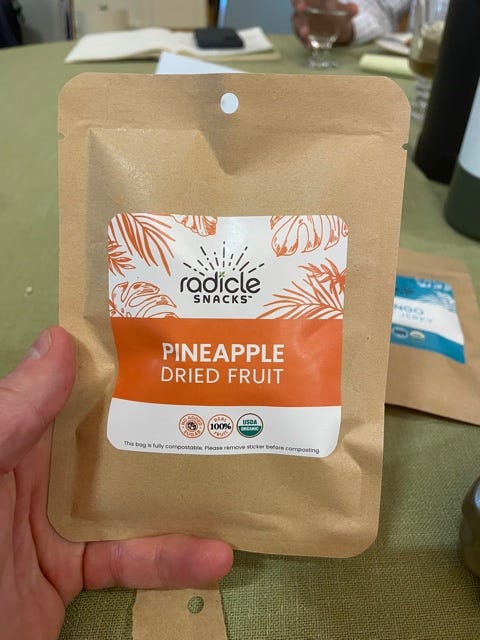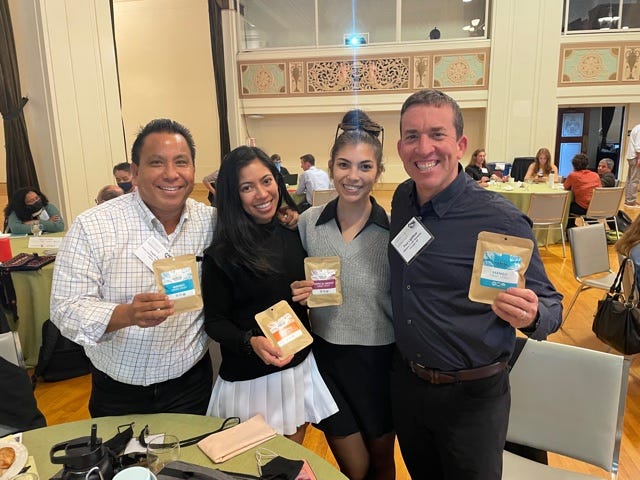Recapping the Regenerative Food Systems Investment Forum
The RSFI Forum (24th) Edition of the Negative Foods Newsletter
I had a terrific time this week at the Regenerative Food Systems Investment Forum in Oakland.
This event brought together many of the best entrepreneurs and investors in the U.S. working to reverse climate change with our food system. It was energizing to be part of the community applying capital to transform one of the world’s biggest and most problematic industries.
Many of the world’s largest investors want to shift their capital toward a more regenerative food system, and the race is on to do so more effectively and quickly.
Some of my takeaways:
Regenerative Needs Definition. If the meaning of “regenerative agriculture” doesn’t get standardized, there is a risk that it will get watered down (like “natural” today). Eric Smith of Grantham explained that a definition may be required to convince some of the most serious investors in the world to make material allocations to the regenerative movement.
We Should Reward Outcomes. I’m sympathetic to those who think we should reward producers for regenerative agricultural practices (no till, animal integration, cover cropping, etc.). But the world needs carbon footprint metrics for food, and in the long run that will come from rewarding producers for carbon removed/stored during the production of Negative Foods. We need to figure out how to measure that outcome, and then reward producers who succeed.
We Must Provide Carbon Footprint Knowledge to Consumers. Consumer demand will be a major factor that shifts market share to Negative Foods. I riff on this idea in these editions of this newsletter: Letter from a Future California, Carbon Labeling Part 1 - The Golden Rule of Food and The Case for Being Bullish. But that demand shift will be slowed if we can’t figure out how to inform consumers about the carbon footprints of their food choices.
The Link between Nutrition & Sequestration will Drive Demand. Dan Kittredge did a great job explaining the link between soil health and nutrient density. The more regenerative the farming practices, the more nutritious the crops, and Dan is working feverishly to help consumers gain that knowledge. Would you choose the more nutritious or the less nutritious carrots? 🥕 I think consumers - when informed - will drive up demand for more nutritious food, and this in turn will drive up demand for Negative Foods.
This is a Big Time Growth Opportunity! More and more companies are producing foods with carbon neutral/negative footprints. It was exciting to see so many new products based on regenerative supply chains. And the quality of the entrepreneurs at this event gives me a ton of hope. Expect great things!
I enjoyed moderating a panel on Wednesday called “Investing in Technologies that Enable a Regenerative System.” Keep on eye on the three early stage investors from that panel, listed below. Their investments in the technologies and companies enabling regenerative agriculture to scale will create the future food system that will help reverse climate change.
Sarah Nolet of Tenacious Ventures. Tenacious is Australia’s first dedicated agrifood tech VC.
Portfolio Company Likely to Remove Most Greenhouse Gasses from Atmosphere: Goterra, which converts food waste into animal feed with insects. Learn more about the company - which provides a “maggot robot” - here.
Recommended Inspirational Book: Sarah’s very own podcast AgTech...so what? (which is great), The Alchemy of Air and Never Split the Difference.
Mark Lewis of Trailhead Capital. Trailhead is a mission-driven investment firm seeking to create outstanding financial, societal, and ecological returns by backing entrepreneurs who are building the regenerative future of food and agriculture.
Portfolio Company Likely to Remove Most Greenhouse Gasses from Atmosphere: Telesense, a food waste mitigation play that reduces the huge percentage of food waste between the harvest and processing of raw commodities.
Recommended Inspirational Book: Deep Economy (which had a major influence on my thinking when I read it in 2008).
Renée Vassilos of the Nature Conservancy.
Portfolio Company Likely to Remove Most Greenhouse Gasses from Atmosphere: Kula Bio, the startup that replaces synthetic fertilizers (from fossil fuels) with fertilizers made from a biological process.
Recommended Inspirational Book: The New Farm and Farm (and Other F Words).
Other players that caught my attention at the RSFI Forum:
Eric Smith of Neglected Climate Opportunities of the Grantham Foundation.
Dan Kittredge of the Biosutrient Association.
Radicle Snack’s Frank Cruz, Cherish Wilson and (the Happiness Creator) Shauna Cancino
And many, many others…
I was also inspired to start drafting future newsletter editions based on Negative Foods I tried and learned about in Oakland. Stand by!
A huge thanks to RSFI organizers Sarah and Anthony. Grateful for your work!
Product Review: Radicle Snacks Dried Fruit
I was lucky to meet with Frank, Cherish and Shauna from Radicle Snacks at the RSFI Forum on Tuesday and Wednesday, as it gave me the chance to enjoy the dried fruit snacks they are bringing to market. Read about their organic regenerative farming practices here. The products are delicious!
For Your Consideration:
Agrifoodtech was the favored destination for climate-focused funding in past 12 months
How tree-planting startup Propagate Ventures monetizes land conservation
Agriculture produces just 1% of carbon credits, data suggests
Nestlé Commits $1.2B To Regenerative Agriculture, Says It’s Ready To Pay Premiums For Raw Materials
The Nation’s First Regenerative Dairy Works with Nature to Heal the Soil—at Scale
How do you transform a corn field into perennial pasture? Animals.
Cargill, Microsoft join $17m round for carbon verification platform Regrow
The big food redesign: Regenerating nature with the circular economy, explains how
Soil health through the lens of the tech stack
Cargill aims to connect farmers to carbon offset buyers
Commitments to mitigate climate change coming to fruition
‘Our biggest challenge? Lack of imagination’: the scientists turning the desert green





